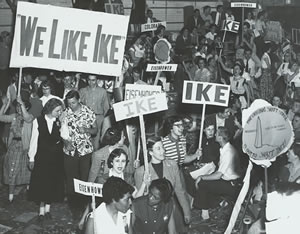 |
 |
 |
||||
 |
|
Oberlin's Conventional Wisdom: The Mock Convention Heritage
In 1860, as the United States was about to go war with itself, Oberlin hosted the first mock political convention ever held on an American campus, beginning a tradition that continued almost uninterrupted for 108 years. The event roused the campus like an old-fashioned religious tent revival, as raucous delegates vied for votes needed to nail down the nomination. “This was not just a plaything for 150 kids, it captured the attention of the whole campus for a year,” says George Bent ’52, former chair of Oberlin’s Board of Trustees, who was a convention delegate in his senior year. The mock conventions were held for just one political party—usually the Republicans, which was a reflection of the College’s tilt toward the GOP for much of its history. They featured elaborate pre-convention parades—complete with floats for each state, and on several occasions a live elephant led GOP processions. “These conventions were not going to affect anything in the real world—we all knew that,” says Robert Rotberg ’55, professor of public policy at Harvard’s John F. Kennedy School of Government. “But we gave our heart and soul for them.” Unlike modern day elections, most presidential nominees of the 19th and 20th centuries were decided not during election primary seasons, but at party conventions, amid feverish power-brokering by political professionals in smoke-filled back rooms. And while Oberlin’s mock conventions mirrored reality as closely as possible, realism wasn’t always met: during one Republican convention, organizers made do with a live cow in lieu of the party’s trademark elephant. But the mock convention tradition fell out of fashion in the late 1960s, in part because 18-year-olds gained the right to vote and in part because primaries became the principle instrument for choosing candidates. “We didn’t know that mock conventions had ever taken place at Oberlin,” says senior Abby Deats, who along with junior Renata Strause headed efforts to resurrect the practice this past spring. Not until they began searching through College history for ways to involve students in Ohio’s March primary did they learn of the election year frenzy that had once taken over the campus.
We knew there had been a parade. We knew there were elephants. We saw pictures of gyms packed with people,” Deats says. “The mock convention had been the thing you looked forward to when you came on campus. It was the big event. We were hoping that by doing it again this year that we could begin to recreate that.” Next Page >> |

